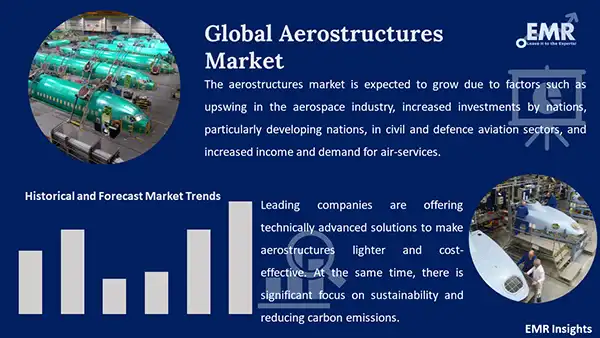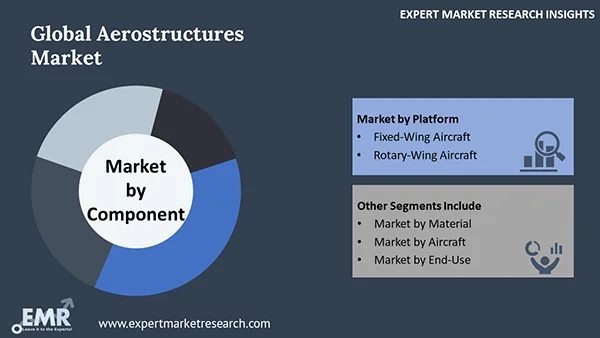
Consumer Insights
Uncover trends and behaviors shaping consumer choices today
Procurement Insights
Optimize your sourcing strategy with key market data
Industry Stats
Stay ahead with the latest trends and market analysis.
The global aerostructures market is expected to grow at a CAGR of 6.30% during the period 2026-2035.
Base Year
Historical Period
Forecast Period
Compound Annual Growth Rate
6.3%
2026-2035
*this image is indicative*
The aerostructures market is expected to be driven by increased aircraft production across the globe, with key drivers including rising global population and demand for passenger and cargo air services, increased flight volume, industrial expansion, advancements in technology, rising personal income, and modernization of old aircraft. Due to growing wealth and population, developing economies would be a key factor driving the demand for aircraft. The various aircraft segments include civil and military aircraft, regional and business jets, jet fighters, freighters and helicopters. Key markets include North America, Europe and Asia Pacific. Developing economies such as China, India and Russia are expected to significantly influence market demand.
The air transport industry is expanding. Every year, airlines across the world transport billions of passengers and millions of tonnes of freight on millions of commercial flights. While this is an indicator of the considerable economic impact of aviation on the world economy, it is noteworthy that aviation accounts for over 3 per cent of the global gross domestic product (GDP). The aviation sector is rapidly growing is expected to grow at a quick pace. Innovations and technological advancements would enable novel business models and mobility services. Significant innovations include autonomous devices, artificial intelligence (AI), internet of things (IoT), ultralight materials, unmanned aircraft innovations, biometrics, robotics, block chain, alternative fuels and electric aircraft.
Aerostructure equipment market would, in turn be characterized by increased efforts of OEMs towards automation and development of enhanced tools and machines, cost-effective and functional tools and machines for smaller OEMs, and efforts to enhance engineering capacities and core competencies. Fulfilling cost targets and quality standards would warrant better technologies, hence, it is expected that novel technologies and innovations would emerge, which would lead to robust demand for advanced solutions. Such solutions (including fully-automated solutions) would, in turn, help boost the aerostructures market. Aerostructures refer to parts of an aircraft’s airframe. These include nacelles and pylons (inlets, fan cowls, thrust reversers, exhausts, engine build up), doors (passenger, cargo, landing gear, utility ramps), flight-controls (ailerons, flaps, slats and spoilers), empennage (rudders and elevators), naval composite structures, and specialized military flight structures.

Read more about this report - REQUEST FREE SAMPLE COPY IN PDF
Global airframe design and aftermarket requirements have witnessed significant change owing to composites and additive manufacturing techniques. Biomimicry, winglets, laminar flow, and longer wing spans are essential elements in lowering fuel consumption and operating costs, and ensuring longer flights and higher maximum take-off weight. Demand for improvements in production rate, REACH compliance requirements, and non-conformities significantly affecting airframe structural design and build processes.
In India, the aerospace industry is growing at a significant pace with increasing activity from civil aviation as well as defence sectors. There is growing demand for large aircraft from Indian carriers. Further, with India’s rising defence capital expenditure, the defence aerospace sector holds much potential, offering opportunities for new start-ups, and existing players to expand. These factors are expected to boost the market.

Read more about this report - REQUEST FREE SAMPLE COPY IN PDF
The EMR’s report titled “Aerostructures Market Report and Forecast 2026-2035" offers a detailed analysis of the market based on the following segments:
By component, the market is segmented into:
By material, the market is divided into:
By platform, the market is classified into:
By aircraft, the market is segmented into:
By end-use, the market is classified into:
By region, the market is segmented into:
The report presents a detailed analysis of the following key players in the market, looking into their capacity, and latest developments like capacity expansions, plant turnarounds, and mergers and acquisitions:
The EMR report gives an in-depth insight into the industry by providing a SWOT analysis as well as an analysis of Porter’s Five Forces model.




*While we strive to always give you current and accurate information, the numbers depicted on the website are indicative and may differ from the actual numbers in the main report. At Expert Market Research, we aim to bring you the latest insights and trends in the market. Using our analyses and forecasts, stakeholders can understand the market dynamics, navigate challenges, and capitalize on opportunities to make data-driven strategic decisions.*
Get in touch with us for a customized solution tailored to your unique requirements and save upto 35%!
The global aerostructures market is projected to grow at a CAGR of 6.30% between 2026 and 2035.
The major drivers of the market include the increasing demand for passenger and cargo air services, increased flight volume, industrial expansion, advancements in technology, rising personal income, modernisation of old aircraft, and growing wealth.
The increased aircraft production across the globe and rising global population are the key industry trends propelling the market's growth.
The major regions in the industry are North America, Latin America, the Middle East and Africa, Europe, and the Asia Pacific.
The various components in the market are wings, nose, fuselage, nacelle and pylon, and empennage, among others.
By material, the market is divided into alloys, metal, and composite.
The different platforms are fixed-wing aircraft and rotary-wing aircraft. Fixed-wing aircraft are further broken down into commercial aircraft, military aircraft, business jets, general aviation aircraft, and UAVs, while rotary-wing aircraft can be sub-divided into commercial and civil helicopters, military helicopters, and UAVs.
The major aircraft of the market is commercial, regional, business, military, and helicopter. Commercial can be further broken down into narrow body and wide body.
The end-uses include OEM and aftermarket.
The major players in the industry are Spirit AeroSystems, Inc., GKN plc, RUAG International Holding AG, Saab AB, Airbus S.A.S., Triumph Group, Inc., Collins Aerospace, Elbit Systems Ltd., among others.
Explore our key highlights of the report and gain a concise overview of key findings, trends, and actionable insights that will empower your strategic decisions.
| REPORT FEATURES | DETAILS |
| Base Year | 2025 |
| Historical Period | 2019-2025 |
| Forecast Period | 2026-2035 |
| Scope of the Report |
Historical and Forecast Trends, Industry Drivers and Constraints, Historical and Forecast Market Analysis by Segment:
|
| Breakup by Component |
|
| Breakup by Material |
|
| Breakup by Platform |
|
| Breakup by Aircraft |
|
| Breakup by End-Use |
|
| Breakup by Region |
|
| Market Dynamics |
|
| Competitive Landscape |
|
| Companies Covered |
|
| Report Price and Purchase Option | Explore our purchase options that are best suited to your resources and industry needs. |
| Delivery Format | Delivered as an attached PDF and Excel through email, with an option of receiving an editable PPT, according to the purchase option. |
Datasheet
One User
USD 2,499
USD 2,249
tax inclusive*
Single User License
One User
USD 3,999
USD 3,599
tax inclusive*
Five User License
Five User
USD 4,999
USD 4,249
tax inclusive*
Corporate License
Unlimited Users
USD 5,999
USD 5,099
tax inclusive*
*Please note that the prices mentioned below are starting prices for each bundle type. Kindly contact our team for further details.*
Flash Bundle
Small Business Bundle
Growth Bundle
Enterprise Bundle
*Please note that the prices mentioned below are starting prices for each bundle type. Kindly contact our team for further details.*
Flash Bundle
Number of Reports: 3
20%
tax inclusive*
Small Business Bundle
Number of Reports: 5
25%
tax inclusive*
Growth Bundle
Number of Reports: 8
30%
tax inclusive*
Enterprise Bundle
Number of Reports: 10
35%
tax inclusive*
How To Order

Select License Type
Choose the right license for your needs and access rights.

Click on ‘Buy Now’
Add the report to your cart with one click and proceed to register.

Select Mode of Payment
Choose a payment option for a secure checkout. You will be redirected accordingly.
Gain insights to stay ahead and seize opportunities.

Get insights & trends for a competitive edge.

Track prices with detailed trend reports.

Analyse trade data for supply chain insights.

Leverage cost reports for smart savings

Enhance supply chain with partnerships.

Connect For More Information
Our expert team of analysts will offer full support and resolve any queries regarding the report, before and after the purchase.
Our expert team of analysts will offer full support and resolve any queries regarding the report, before and after the purchase.
We employ meticulous research methods, blending advanced analytics and expert insights to deliver accurate, actionable industry intelligence, staying ahead of competitors.
Our skilled analysts offer unparalleled competitive advantage with detailed insights on current and emerging markets, ensuring your strategic edge.
We offer an in-depth yet simplified presentation of industry insights and analysis to meet your specific requirements effectively.
Share